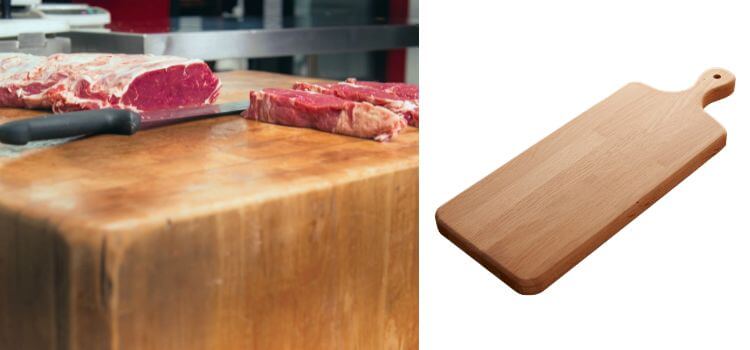As an Amazon Associate, I earn from qualifying purchases

When prepping ingredients in the kitchen, the surface you use can significantly affect functionality and aesthetics. This article explores the nuanced debate between butcher blocks and cutting boards, examining their distinct features, benefits, and factors to consider. Our goal is to assist you in determining which surface best meets your culinary requirements.
Whether you’re an experienced home chef or a fervent food lover, understanding the distinctions between these kitchen essentials is essential for enhancing your cooking experience.
What is a Butcher Block?
A butcher block is a heavy, sturdy kitchen surface typically made from hardwood such as oak, maple, or cherry. This cutting board stands out due to its notable thickness and robustness, rendering it perfect for a variety of kitchen tasks, including chopping, dicing, and slicing all types of ingredients.
Unlike traditional cutting boards that are usually 1 inch thick or less, butcher blocks can range from 2 to 6 inches thick, providing a stable and solid surface for heavy-duty cutting tasks.
Advantages of using a butcher block
- Durability: The dense and robust characteristics of butcher blocks enhance their durability, enabling them to endure heavy use while resisting signs of wear and tear.
- Knife-friendly: Butcher blocks are gentle on knives due to their thick and forgiving surface, helping to maintain the sharpness of your blades.
- Versatility: Butcher blocks can be used for various kitchen tasks, from chopping vegetables and fruits to carving meats and serving as a temporary cooling rack.
- Aesthetic appeal: The natural beauty of hardwood butcher blocks adds warmth and charm to any kitchen space, making them a popular choice for both practical and decorative purposes.
Disadvantage of using a butcher block
- High maintenance: To maintain their optimal condition and prevent bacterial accumulation, butcher blocks necessitate consistent upkeep, including regular oiling and sanding.
- Heavyweight: The thickness and density of butcher blocks make them quite heavy, making it challenging to move them around or store them when not in use.
What is a Cutting Board?
A cutting board provides a stable, movable platform for food preparation tasks. It can be made from various materials such as wood, plastic, or bamboo and comes in various shapes and sizes. Most traditional cutting boards are thinner than butcher blocks and may have a handle for easy transport.
Advantages of using a cutting board
- Ease of use: Cutting boards are lightweight and easy to move around, making them convenient for daily use in the kitchen.
- Low maintenance: In contrast to butcher blocks, cutting boards are low-maintenance and can be effortlessly cleansed using just soap and water.
- Affordability: Cutting boards generally come at a lower price point than butcher blocks, offering an economical choice for home chefs.
- Variety: Cutting boards come in various materials, shapes, and sizes, providing various options according to personal preferences and specific kitchen needs.
Disadvantages of using a cutting board
- Durability: Cutting boards made from softer materials such as plastic or bamboo may not be as durable as butcher blocks and must be replaced more frequently.
- Knife damage: The hard surface of some cutting boards can dull knives over time, requiring more frequent sharpening.
Factors to consider: Butcher Block vs Cutting Board
- Intended use: Consider the types of ingredients you will primarily be prepping on the surface. If you plan to cut large, heavy meats or use sharp knives frequently, a butcher block may be better.
- Kitchen space: The size and thickness of butcher blocks make them more suitable for larger kitchens with ample counter space. Cutting boards are better suited for smaller kitchens with limited work areas.
- Maintenance: As mentioned earlier, butcher blocks require more maintenance than cutting boards. If you have limited time for upkeep, a cutting board may be a more practical option.
- Budget: Butcher blocks are generally more expensive than cutting boards, so your budget may affect your decision.
Maintenance and Care for Butcher Blocks and Cutting Boards
To keep both butcher blocks and cutting boards in top condition, here are some essential maintenance tips to follow:
- Regularly clean your surface after each use with hot, soapy water.
- Dry thoroughly: After cleaning, dry the surface completely before storing or using it again.
- Oil regularly: Butcher blocks should be oiled every 3 to 4 weeks, while cutting boards can be oiled monthly.
- Prevent cross-contamination: Use separate boards or clean your surface thoroughly before switching between cutting raw meats and other ingredients.
Conclusion: Butcher Block vs Cutting Board
In conclusion, both butcher blocks and cutting boards have unique advantages and considerations that you should consider. While butcher blocks offer unmatched durability and versatility, cutting boards are more budget-friendly and easy to maintain.
Consider your specific needs and preferences to determine which surface best fits your kitchen. With proper care, both options can provide a functional and aesthetically pleasing addition to your culinary space. Happy cooking!
As an Amazon Associate, I earn from qualifying purchases